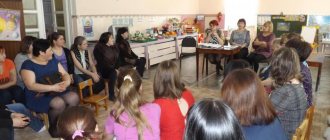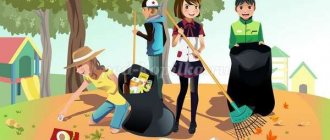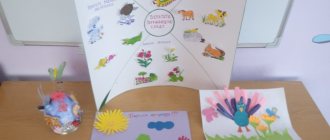Signs about the weather in February
- In early February it is warm and the snow is melting - a mediocre harvest.
- If February is cold, it means a favorable summer.
- February is cold and dry - August is hot.
- Warm February means a cold spring, and frosty February means a favorable summer.
- There is a lot of frost in February - in summer there will be a lot of dew and a lot of honey.
- Bright stars in February indicate frost, dim stars indicate thaw.
- If February turns out to be rainy, then spring and summer can be expected to be the same. A fine February foreshadows drought in the summer.
- Severe frosts mean a short winter.
- At the end of February there are a lot of long icicles - for a long spring.
- Snowless February threatens summer drought.
- The colder the last week of February, the warmer it will be in March.
- Thunder in February means strong winds.
Parent meeting in the secondary group “Ecology and us”
Parent meeting in the secondary group “Ecology and us”
Target:
1. Increase parents’ interest in environmental education of children and ecology in general.
2. Involve parents in the work of the group and kindergarten to form an environmental culture for preschoolers.
Meeting plan:
1. Conversation “What is environmental education?”
2. Game "Chamomile"
3. The word is a relay race
4. Preparation for the summer period, assistance from parents in arranging and landscaping the site.
5. Miscellaneous.
Progress of the meeting:
Parents sit down, fill out a registration sheet, while music from the program “In the Animal World” plays.
Educator: Good evening, dear parents! Thank you for taking the time to come to the parent meeting. After all, the leading role in raising a child belongs to the family and its way of life. The family is a source that nourishes a person from birth, introduces him to the environment, and gives him the first knowledge and skills.
More and more often we hear and pronounce the word “ecology”. It is advisable to start environmental education from early childhood, developing an understanding of the beauty of nature and love for it.
What is environmental education? (Parents' answers).
This is the knowledge of living things that are close to the child, in interaction with the environment, and on this basis the development of the correct forms of interaction with him. By attracting children to close communication with nature, to the knowledge of communication with nature, knowledge of the world of plants and animals, we, adults, contribute to the active development in children of such qualities as kindness, patience, hard work and mercy. These traits, laid down in childhood, will firmly become part of a person’s character and become his foundation. Then you can be calm for nature and the younger generation.
Preschool childhood is the initial stage of the formation of a person’s personality, his value orientation in the world around him. During this period, a positive attitude towards nature, the “man-made world”, towards oneself and the people around them is formed.
“Life today is impossible without environmental knowledge. We, people, need them like air, like a cure for a disease, the diagnosis of which is indifference to our common Home, to Nature” (Valery Arkadyevich Alekseev - historian and philosopher).
Nature itself makes it possible to comprehensively develop a child, broaden his horizons by showing the relationships in nature, involve children in joint activities, encourage the child to sympathize, empathize, and desire to help with deeds. What will help us first? (Parents' answers).
Yes, these are various walks and observations, during which it is necessary to teach the child to draw independent conclusions while observing weather phenomena. Maintain interest in the surrounding world, animate and inanimate natural phenomena.
While walking, observe what is happening in nature, enrich children with new knowledge, which will be the basis for a conscious attitude towards it, and also develop a sense of beauty in children.
Environmental education is a continuous process of training, education and development of a child, aimed at developing his environmental culture, which manifests itself in an emotionally positive attitude towards nature.
As practice shows, modern preschoolers have a large amount of knowledge about nature. However, this knowledge is often formed spontaneously, under the influence of television programs, advertising, and cartoons. Only in the process of purposeful work of the kindergarten and parents can an ecological culture, ecological thinking, and environmental consciousness be formed in children.
Happiness is being with nature, seeing it, talking to it. We must cherish this happiness and teach it to our children.
Nature is an inexhaustible source of aesthetic feelings and experiences. You cannot love nature without knowing it. The more you know, the more you understand and love. In a few years, our children will become adults. And responsibility for the life of our society, for the fate of our land will fall on their shoulders. And it depends on us adults whether they will love and take care of our nature, whether they will be able to foresee the consequences of their activities in the ecological environment.
Seasons... They usually replace each other, and over the years we adults cease to be surprised and rejoice at how the colorful splendor of autumn gives way to the severity of the black and white graphics of winter, how the barely visible watercolor spots of spring are overshadowed by the generous multicolor palette of summer. And only sometimes the smell of rotten leaves or the bizarre shape of a cloud suddenly awakens in us memories of childhood - of that amazing time when the onset of each new season became perhaps the most important event of our lives.
And how we loved walks! Because on the street we could jump, run, study the contents of puddles, watch the ice melt in warm hands, watch the crows cry...
In a word, we, without even suspecting it, were experiencing the world in all its beauty, developing and strengthening physical health, observing and drawing conclusions.
In preschool age and in favorable conditions, the intellectual and volitional sphere of the child intensively develops, the foundations of a correct, conscious attitude to objects and phenomena and the surrounding reality are laid. An important factor influencing children is purposeful, systematic educational work, in which the purposeful process of getting to know nature occupies a particularly important place.
What attitude towards nature can we instill in children? (Parents' answers):
— Berezhnoe
— Caring
— Humane
It is necessary to teach to see the beauty of living things, appreciate it and strive to help it (in winter - feed birds, shake snow from tree branches).
To develop an interest in knowledge, to explore the world around us, to help the child learn more about the secrets of living and inanimate nature.
To form a desire to become a friend and defender of nature, to cultivate a caring attitude towards nature.
The outstanding Irish playwright Bernard Shaw said: “I have an apple, you have an apple, let’s exchange them, everyone will still have one apple. I have a thought, you have a thought, let’s exchange them, there will be two thoughts.” And now I invite you to also exchange thoughts and play the game “Chamomile”
Parent meeting “Environmental education of preschool children”
Working with parents in preschool educational institutions.
Parent meeting on the topic: “Learning to love nature”,
Popova Elvira Ivanovna, kindergarten “Rainbow”, Republic of Mari El
Goal: to teach the parents of the group to instill in their children a love of nature and their native land
Good evening, dear parents. We are glad to see you, we are glad that you responded to our invitation to communicate, because only through joint efforts can we achieve the desired results.
What do you think a family is and what does it mean for a person?
Family is the most precious and dear thing that every person has. “The family is the very environment in which a person learns and does good,” said V.A. Sukhomlinsky. For a child, the family is a model of society through which he enters the world. The family has a leading place in the development of a child, therefore, in raising a child, priority undoubtedly belongs to the family.
Childhood is the most favorable period for the development of all qualities of a child’s personality. Having gone to school, he will carry away the germs of good or evil in his soul. He will part with the teacher, but at the same time he will forever remain with his parents. But when the child grows up, who will the aging parent see next to them: a kind, caring person or a cruel, indifferent person? This primarily depends on the parents themselves. No wonder the proverb says: “If you know how to give birth to a child, you know how to teach it.”
Parents should determine for themselves the goals of education, what kind of person do they want their child to be?
I suggest you answer a number of questions that will help us in our future work with children.
Interviewing parents.
(Calm music sounds.)
The world has changed a lot over the past decades. It's no secret that there are environmental problems on Earth that threaten the health and lives of people.
Why do you think this happened, what are the reasons?
- Environmental pollution.
— Reduction of forest area.
— Desertification of the soil, its contamination.
- Changing of the climate.
— Ozone holes.
Closely intertwined with these problems are problems that are related to people’s lives: these are problems of energy, transport, health and litany. What is the way out of this situation, what
should be done?
(parents' statements)
Today, the continued existence of life on earth depends on you and me.
It is advisable to begin environmental education from early childhood, with the development of an understanding of the beauty of nature, love for it, and an orientation towards the good and beautiful that is inherent in it.
Russian nature. These words immediately evoke various pictures in the memory of every person: a slender pine forest, a cheerful birch grove, water meadows, golden grain fields.
It is difficult to find a person indifferent to his native nature. I took nature as my mentor - the Greatest of all teachers.
With the help of the natural environment, adults have the opportunity to comprehensively develop a child: expanding his horizons, showing relationships in nature, involving children in joint activities, giving feasible assignments, encouraging the child to sympathize, empathize, and cultivating a desire to help with deeds.
From nature, man learns beauty, a sense of proportion, goodness, and justice.
— How to introduce a child to his native nature?
— How to develop
his cognitive interest in her, cultivate
love
and caring attitude?
First of all, it is necessary to expose the child to the wonders of living nature, give the opportunity to admire a tree and a bush, a cat and a jackdaw... An encounter with nature should be a holiday for the child, which we, adults, must prepare.
A sensitive child's soul, which since childhood has known the feeling of enjoying the beauty of nature, will certainly touch the most necessary strings of human character. It’s hard to live in the world without three things: art, love and memories. The teacher J. Korczak spoke about this: “The education of pure and noble feelings in the hearts of children is more necessary and more valuable than enrichment with various knowledge.”
No matter how many conversations we have with children about nature, about caring for it, we will not achieve the desired result until we take the child out into nature, until we ourselves set an example of a careful and caring attitude towards it.
— What will help us first?
(parents' answers)
-Yes, these are walks and various observations. And then various trips to the forest, to the meadow, to the field, to the river.
While walking, observe what is happening in nature, enriching children with new knowledge, which is the basis for a conscious attitude towards it, and also develops their sense of beauty. At the same time, remember that feelings are the fundamental basis of relationships.
— What attitude towards nature can we cultivate in children?
(parents' answers)
We must teach children to see the beauty of living things, appreciate it and strive to the best of their ability to protect it, helping it, for example, in winter - feeding birds, shaking snow from tree branches. In the spring - hanging birdhouses. In autumn - collecting food for birds, etc.
A child is inquisitive by nature. He is interested in everything new, unknown. He has discoveries every day, he learns - he gets to know the world around him. His curiosity and interest in the unfamiliar increases, which manifests itself in his constant questions.
Every child is an explorer by nature. The questions that children ask us are just a small part of their unresolved “problems.” Look in the child’s pockets, what is there: a round river pebble, a bird feather, a piece of pine resin... So it turns out that all these “jewels” collected by the children are a kind of materialized “why”, “why”, “how”.
Until the sparks in the eyes of little researchers fade away, until interest in knowledge and exploration of the world around them is lost, we need to help the child discover as many secrets of living and inanimate nature as possible. — Do you think it’s good or bad if children ask questions?
Children's questions indicate a high level of child development. If children ask them, it means you managed to interest them. Questions not only help children see and understand the world, but also enrich the mind with unexpected discoveries. The child should come to us with questions, and our task is to raise these questions. Children usually ask a lot of questions about nature.
— Do you need to answer them immediately, what do you do?
(parents' statements)
Sometimes it is useful to “cheat” by saying that you don’t know the answer. It is possible to even answer incorrectly if you are sure that the child knows the answer, since his correct answer will give him pleasure. You can invite your child to observe the phenomenon and find the answer.
— Does your child ask you questions? How often?
(parents' answers) I suggest you answer a number of questions.
- Why do animals need tails?
—What animal gives birth to babies during leaf fall? —Whose leaves fall green in autumn? (alder, lilac) - Why does the fox run all winter while the bear sleeps?
— What birds hatch chicks in winter and why?
— It’s good if you use folk signs when observing the weather. Familiarity with signs makes it possible to conclude how observant our people are, how they knew how to notice everything in nature. Our task is to convey, surprise, and evoke a desire to determine the weather using numerous natural barometers.
— What signs do you know? — Do you introduce children to them?
Among the wide variety of natural objects, children often get lost; they are poorly oriented and do not remember the names.
— How can you help children?
(parents' statements)
Knowing that the leading activity of preschoolers is play, this can be solved with the help of such gaming techniques as asking riddles and guessing by description. Writing your own riddles, songs, poems. Selecting comparisons and epithets for natural phenomena. Reading additional educational literature and using poetic words. By organizing joint viewing of television programs about nature. Playing board games with natural history content at home, giving the child the opportunity to draw and sculpt, perform appliqué, making handicrafts from natural materials together.
To develop the ecological culture of a preschooler, it is necessary to influence the emotional sphere of the individual, forming moral, aesthetic and intellectual feelings towards nature.
Happiness is being with nature, seeing it, talking to it. We must cherish this happiness and teach it to our children.
Parent meeting decision
1. Organize regular walks into nature in the family in order to cultivate love for it.
2. Use the summer period to travel outside the city and introduce children to the nature of their native land.
3. Maintain children's interest in nature and encourage their curiosity.
4. Provide children with the opportunity to reflect their impressions gained from communicating with nature through drawing, modeling, and appliqué.
5. Assemble a photo album “Nature and Children!” in the group. (term)
6. Hold a drawing competition “Drawing nature with your child.”
Literature.
1. Nikolaeva S.N. Young ecologist. Environmental education program
2. Electronic resource. Access mode https://nsportal.ru/detskiy-sad/materialy-dlyaroditeley/2012/02/06/vospitanie-lyubvi-k-rodnoy-prirode-v-seme



